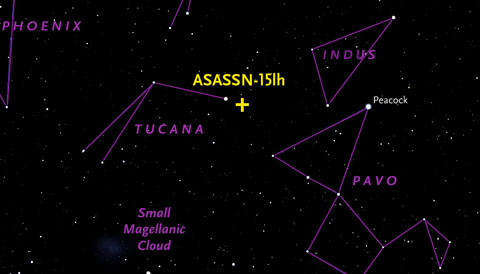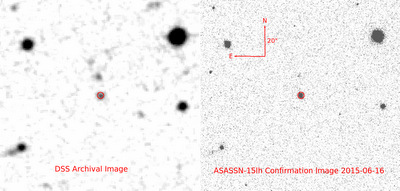Astronomers have discovered an exploding star that belongs to the "superluminous" class, and it's the most luminous one ever found.
A new light source popped into images taken as part of an all-sky survey starting in late May this year. With follow-up observations in hand, astronomers now think this is the most luminous supernova ever observed. It shines with the luminosity of 572 billion Suns.

Sky & Telescope diagram; source: Stellarium
Dubbed ASASSN-15lh, this supernova was found as part of the All Sky Automated Survey for SuperNovae (ASASSN), which relies in part on the observations of Cassius, twin 14-centimeter telescopes in Cerro Tololo, Chile.
Astronomers across the Southern Hemisphere have conducted follow-up observations using several telescopes, including the robotic 1-meter telescope in Chile that's part of the Las Cumbres Observatory Global Telescope Network, the du Pont 2.5-meter telescope at Las Campanas Observatory, South Africa's 10-meter SALT telescope, and several others.
Spectra have confirmed that the object's blue-colored light has been traveling toward Earth for the past 2.8 billion years. (That's a redshift, z, of 0.2326.) The light also appears to lack hydrogen features, which means that the star would have lost its outer hydrogen-rich layers in a wind prior to exploding.

Astronomer's Telegram
Subo Dong (Kavli Institute for Astronomy and Astrophysics at Peking University, China) wrote in the Astronomer's Telegram that the object appears to be one of the superluminous supernovae, a rare class that shines with luminosities 10 to 100 times brighter than those of "normal" supernovae. These are also typically larger in physical size and hotter. A paper on the discovery is now available on the preprint arXiv.
Normally, most of a supernova's light comes from radioactive nickel-56, synthesized in the star's core before it runs out of fuel to sustain itself against gravity's pull. This radioactive element decays and produces gamma rays, which heat the surrounding material: the more nickel-56, the brighter the supernova. But hydrogen-poor superluminous supernovae (SLSN Class I in astronomer-speak) fade too rapidly for the luminosity to come entirely from nickel-56 — some unknown mechanism powers their extreme luminosity. Whether that remains true for this new supernova remains to be seen. Stay tuned...
 10
10









Comments
July 14, 2015 at 2:50 am
R u sure is not an asteroide?
You must be logged in to post a comment.
Peter Wilson
July 14, 2015 at 1:44 pm
Extraordinary claims require clarification.
Many astronomical sources are beamed, and so the inverse-square-law does not apply. Was this one? Did it put out the luminosity of 572 billion Suns? Or did it put out the luminosity of 2.3 billion suns, but pointed right at us, such that if spread over the entire sky, it would have equaled 572 billion Suns?
You must be logged in to post a comment.
Monica YoungPost Author
July 15, 2015 at 2:47 pm
Peter, you ask great questions and I am as intrigued as you are to see what astronomers are able to glean from this discovery!
You must be logged in to post a comment.
July 14, 2015 at 9:49 pm
Only a pair-instability supernovae can produce a supernovae with a luminosity that is 572 times that of our sun. These are incredibly massive stars, 130 to 250 times the mass of our sun. When they explode they leave nothing behind, not even a black hole. Since this supernovae did not include hydrogen in its spectra, that would make it a Type Ib supernovae. If it was also missing helium in its spectra, it would be a Type Ic supernovae.
You must be logged in to post a comment.
Monica YoungPost Author
January 15, 2016 at 2:24 pm
By definition, all Type I supernovae are hydrogen-poor, and all Type II are hydrogen-rich. You are thinking helium, I think: Type Ib supernovae show helium in their spectra, Type Ic do not.
You must be logged in to post a comment.
stewl
July 17, 2015 at 5:01 pm
With the exception of a tiny black dot in the left center margin on the right image, I do not see any other object in the right image that is not in the left image. There seems to be more background 'noise' in the right image. Which one is the exploded star in the right image?
You must be logged in to post a comment.
Jim-Baughman
July 20, 2015 at 9:23 am
I'm having trouble reading the side-by-side comparison images myself. In the center of both is a black dot circled in red. Presumably that's what our attention is being drawn to--but what exactly are we supposed to see? The red circle makes it hard to see both black dots.
Also, the image is next to microscopic. This alas is true of most images that accompany these fine articles. Please, PLEASE S&T pay attention to both the SIZE and the CLARITY (i.e. accompanying explanations) of the images that go with these articles. You do the fine journalism a tremendous disservice by posting these disappointing images.
You must be logged in to post a comment.
July 20, 2015 at 3:21 pm
There is not supposed to be a difference. The LH image is the discovery image by ASAS-SN and the RH one the confirmatory LOGT data. Click on Astronomer's Telegram check ths; S&T are wrong to say the LH data are pre-discovery. The last pre-discovery magnitude (above their limit) starts the numerical table which follows the object as it brightened. Both images are V-band. Ted circles are around the new object.
You must be logged in to post a comment.
Monica YoungPost Author
August 17, 2015 at 2:30 pm
Sorry, this is not correct. The left-hand image is an archival image that shows the host galaxy before the supernova. The right-hand image shows the host galaxy plus the increase in intensity from the supernova. Since the host galaxy is just barely resolved and the supernova not at all (i.e., it's just a point source), this increase in intensity shows up as a slightly bigger and darker clump of pixels. If you click on the link provided in the caption, you'll see the full report.
You must be logged in to post a comment.
July 20, 2015 at 4:31 pm
Re last: better Red than Ted.
You must be logged in to post a comment.
You must be logged in to post a comment.